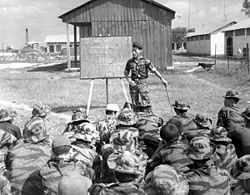| Civilian Irregular Defense Group | |
|---|---|
 CIDG unit training | |
| Active | 1961–1970 |
| Country | |
| Allegiance | |
| Branch | |
| Type | Militia |
| Role | Anti-guerrilla warfare Artillery observer Bomb disposal Border security Close-quarters battle Counterinsurgency Force protection HUMINT Irregular warfare Jungle warfare Mountain warfare Raiding Reconnaissance Tracking |
The Civilian Irregular Defense Group (CIDG, pronounced /ˈsɪdʒiː/, SID-jee; Vietnamese: Lực lượng Dân sự chiến đấu) was a military program developed by the Central Intelligence Agency (CIA) during the Vietnam War, which was intended to develop South Vietnamese irregular military units (militia) from indigenous ethnic-minority populations. The main purpose of setting up the CIDG program was to counter the growing influence of Viet Cong (VC) in the Central Highlands by training and arming the villagers for village defense. The program rapidly expanded after the US military transferred its control from CIA to MACV after two years since its inception and changed its focus from village defense to more conventional operations. From June 1967 onwards the CIDG members were made part of the Army of the Republic of Vietnam (ARVN) or other government agencies to increase Vietnamese participation. By late 1970, the remaining CIDG camps were converted to Vietnamese Rangers (ARVN Rangers) camps. The indigenous ethnic-minority people that formed the CIDG reaped significant benefits by the government of South Vietnam for their allegiance and it was the first time that minority groups were given full status as citizens of South Vietnam.